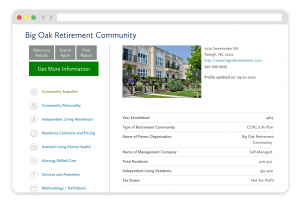Choosing the right retirement community is a major decision that impacts your lifestyle, finances, and long-term peace-of-mind. But with so many community options, it can be quite confusing and even overwhelming. For instance, one of the more frequent questions we hear from consumers relates to the differences between a for-profit and nonprofit CCRC (continuing care retirement community, also called a life plan community).
Differing missions and governance
While both for-profit and nonprofit models can offer excellent amenities and care, it is important for prospective CCRC residents to understand that their missions, priorities, and financial structures can differ in meaningful ways.
Nonprofit CCRCs are typically organized as tax-exempt 501(c)(3) entities and often operate with a strong mission-driven focus, particularly those affiliated with religious organizations. Others may not be affiliated with a religious organization but still maintain nonprofit status under a decades-old IRS ruling that considers providing services to meet the needs of the aged a charitable purpose for federal tax purposes.
One of the more common appeals of a nonprofit CCRC is that all revenue is reinvested back into the organization as opposed to being paid out to owners or investors. An exception to this would be any portion of revenue that goes towards debt service payments. In this sense, lenders or bondholders may be akin to investors in a for-profit.
Governance of a nonprofit CCRC is usually provided by executives and a volunteer board of directors. Ideally, there are at least a couple of residents on the board, as well as an active resident council that is valued for the guidance and feedback offered. This structure helps ensure that decisions are made with residents’ long-term interests in mind. Day-to-day management may be handled internally or outsourced to a third-party management company.
For-profit CCRCs, by contrast, are typically owned and operated by corporations or investors. In some cases, the owner may have a long track record of developing and managing senior living communities. In other cases, it could be a REIT or other type of investment fund that owns a large percentage of the organization.
While some nonprofit CCRCs still operate as single-site communities, most for-profit CCRCs are part of larger multi-site organizations. Like any for-profit business, their primary objective is to generate revenue and provide returns to shareholders. This isn’t inherently negative; a well-managed for-profit organization can achieve strong financial performance while still providing exceptional service to its residents. In fact, over the long term, it would be quite difficult to maintain profitability while also having low resident satisfaction.
>> Related: What’s the Difference Between a Nonprofit and Not-For-Profit?
Varying resident financial support
Another key difference between nonprofit and for-profit CCRCs is the level of financial support available to residents. Many nonprofit CCRCs maintain a long-standing tradition of not forcing residents to leave due to a lack of funds. As a result, nonprofit CCRCs may offer financial assistance or benevolent care programs that help residents remain in the community if they exhaust their financial resources through no fault of their own.
However, these nonprofit organizations are still businesses that must be financially responsible. Contract language in a non-profit CCRC therefore often includes language such as:
“The community may offer financial assistance to a resident who has encountered financial difficulty, provided the resident has managed his or her resources properly after taking occupancy … such assistance will be conditional on the community’s ability to provide funds while operating on a sound financial basis.”
In addition to any internally designated financial assistance funds, many non-profit CCRCs also maintain benevolent funds or resident-supported endowments to help those in financial distress. Still, the presence of such a fund does not guarantee support. It must be consistently and adequately funded over time. Indeed, a community’s ability to provide financial assistance hinges on its financial strength and stability.
For-profit CCRCs, on the other hand, are generally less likely to provide this kind of support. This can be an important consideration for those concerned about outliving their assets. It is worth noting that while this practice is far more common with non-profit CCRCs, there are some for-profit providers that offer financial assistance or maintain a separate endowment fund for resident financial support.
>> Related: Assessing the Affordability of a Life Plan Community
Confidence about long-term affordability
All this being said, the likelihood of a resident requiring financial assistance should, in theory, be relatively low. Most CCRCs conduct a financial qualification process for new residents to help ensure long-term affordability. Many use a preliminary assessment tool like MoneyGauge by myLifeSite as an easy first step before going deeper into the financial conversation. And in cases where residents hold a refundable entry fee contract, the refundable portion is often advanced to cover healthcare or living expenses before other financial assistance is accessed.
Additionally, for senior living providers that accept Medicaid, government assistance may become available if a resident’s personal funds are depleted. Keep in mind that residents found to have inappropriately divested their assets may be denied financial support for a period of time, and potentially the care they need.
As with any critical aspect of the CCRC decision-making process, it’s important to have a transparent discussion with the finance director and, if possible, a resident council or board representative involved in financial matters. Ask about the history and financial aid availability, the current funding status of any benevolent or endowment funds, and review the specific contract language that governs such assistance.
>> Related: Gifting Assets Can Create Five-Year Lookback Period Issues
How to evaluate a CCRC
The decision to move to a CCRC will have implications on a person’s long-term happiness, health, and finances. Therefore, when exploring CCRCs, don’t stop at the surface (such as whether it is a nonprofit or for-profit community).
Take time to understand the organization’s overall financial standing, governance structure, and fiscal history. Review audited financial statements, ask about occupancy rates, and inquire about the organization’s debt levels and long-term financial plans. Understand how fee increases are managed and whether there is a safety net for residents in financial distress.
Also consider the culture and values of the community. Is there transparency in decision-making? Are residents given a voice? What is the reputation of the leadership team, and how often does team membership change?
Touring multiple communities, speaking with current residents, and consulting with a financial advisor can provide additional invaluable insights. Each retirement community is different, and finding one that aligns with your financial goals, lifestyle preferences, and personal values is key to a successful move and long-term satisfaction with your senior living decision.
>> Related: How to Have Confidence a CCRC Will Be a Sound Long-Term Investment
Nonprofit CCRC or for-profit CCRC: Finding your right fit
Whether a CCRC is structured as nonprofit or for-profit is just one part of the bigger picture. As with any industry, there are good senior living operators and not-so-good operators; this isn’t specific to nonprofit or for-profit communities. What truly matters is how a community operates in practice: how it treats its residents, manages its resources, and plans for a secure future.
By understanding the differences between the nonprofit and for-profit CCRC models and asking the right questions, you can choose a community that not only meets your needs today but also provides security and support for the years ahead. With the right information and a thoughtful approach, your next chapter can provide both fulfillment and peace of mind.
Originally posted June 27, 2016; updated July 7, 2025

FREE Detailed Profile Reports on CCRCs/Life Plan Communities
Search Communities






